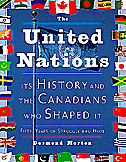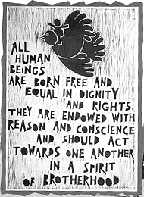


|
The United Nations: Its History and the Canadians Who Shaped It.
Desmond Morton.
Toronto: Kids Can Press, 1995. 65pp, paper, $18.95.
ISBN 1-55074-222-1.
Grades 5 - 9 / Ages 10 - 15.
Review by Caroline Thomson.
|
excerpt:
If you and other people in your neighbourhood wanted to get something
done, you begin by getting organized. Why not start a neighbourhood
association? You would need to hold a meeting, or assembly, where each
family would have one vote. If fighting is a problem in your area, you
might choose a special peace committee. It would be smart to include the
richest and most important families on the committee, because if they don't
keep the peace, no one will. You could also form a committee to improve
living conditions. And since there'll probably be arguments in your
neighbourhood, how about a ``court" to find a fair agreement.
The UN has all of these organizations and many more.
On October 24, 1945, a group of thirty-one countries formally joined
together to become the United Nations. Their purpose was to ``save
succeeding generations from the scourge of war." This year marks the
fiftieth anniversary of the founding of the UN, and in honour
of that, many books on the institution are being published. Distinguished
Canadian historian Desmond Morton has written The United Nations: Its
History and the Canadians Who Shaped It, a book directed at
Canadian youth.

The United Nations has been in the news frequently over the last
few years, and many children will have some idea of what it is and for what
it stands. The UN is not an easy concept to explain; nonetheless, Morton
manages to make his descriptions clear and easily understandable. He
compares the world to a neighbourhood and the UN with a neighbourhood organization. In this way he explains why certain committees and
organizations exist and what purpose they serve. (The analogy will also
provide instructors with many ideas for classroom activities for studying
the UN.)
Morton's book covers the history of the UN, why, where, and how it
began, and explains its relationship to its predecessor, the League of
Nations. He includes brief accounts of the role the UN has played in
trying to manage many conflicts over the years, from the Suez Crisis in
1956 to the situation in the former Yugoslavia today.
Morton also deals with some of the difficulties or even failures
that the UN has faced. He does not attempt to portray the UN as perfect or
shy away from the organization's problems. On the other hand, he does
not attack it. He clearly feels that there is a benefit to keeping the UN
in place and continuing to support the work it does. So the book may be
biased in the UN's favour -- but then a book emphasising its failures would
provide a bleak picture of our world.
But this book is also specifically about Canada's role in the
organization, and the many Canadians who have played important parts in its
history. The information is presented in short, concise sections that are
easy to understand and absorb. There are also many photographs of the
personalities and places of the UN.

The book includes a glossary of unfamiliar terms and recommends to
readers at the beginning that they refer to it when needed. There is also
an index. Throughout, Morton refers readers to other relevant sections of
the book to help clarify points or provide more information.
All of the information in The United Nations: Its History and
the Canadians Who Shaped It is important and relevant. The focus
on the Canadian role within the UN should help foster pride in our
nation.
Kids Can Press gives the recommended age range for The United
Nations as ten to fifteen. Although the information in the book
would be useful for students aged fifteen or older, the presentation would
seem too simple -- even condescending. I'm giving it an age range of ten to
thirteen.
Recommended.
Caroline Thomson is a librarian in North York, Ontario. She holds an
M.A. in history.
For ordering information contact Kids Can Press at 1-800-565-9523

Copyright © 1995 the Manitoba Library Association.
Reproduction for personal use is permitted only if this copyright notice
is
maintained. Any other reproduction is prohibited without permission.
Published by
The Manitoba Library Association
ISSN 1201-9364
 Go back to CM Welcome page
Go back to CM Welcome page
 Go back to Table of
Contents for this Issue
Go back to Table of
Contents for this Issue





![]()
 Go back to CM Welcome page
Go back to CM Welcome page Go back to Table of
Contents for this Issue
Go back to Table of
Contents for this Issue